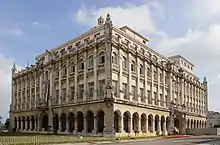Havana Presidential Palace attack (1957)
The attack on the presidential palace in Havana took place at around 3:30 PM on the March 13, 1957. The Directorio Revolucionario Estudiantil had the objective of killing Fulgencio Batista. The attack failed.[2] According to one of the attackers, Faure Chomón of the Revolutionary Directorate, they were following the golpe arriba strategy and together with Menelao Mora Morales sought to overthrow the government by killing President Fulgencio Batista.[3]
| Havana Presidential Palace attack (1957) | |||
|---|---|---|---|
| Part of the Cuban Revolution | |||
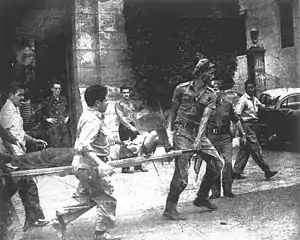 Presidential Palace Attack Havana, Cuba. 13 March 1957 | |||
| Date | 13 March 1957 | ||
| Location | Havana, Cuba | ||
| Caused by | Tyranny | ||
| Goals | Remove Batista from power | ||
| Methods | Surprise attack | ||
| Resulted in | Failure | ||
| Parties to the civil conflict | |||
| |||
| Lead figures | |||
| |||
| Number | |||
| |||
| Casualties | |||
| Death(s) | 30 | ||
| Arrested | 2 | ||
| Detained | 2 | ||
| Charged | 2 | ||
Plan
The plan, as explained by Faure Chaumón Mediavilla, was to attack the Presidential Palace by a commando of fifty men and simultaneously support the operation by one hundred men occupying the radio station Radio Reloj at the Radiocentro CMQ Building to announce the death of Batista.[1] The attack on the palace would result in the elimination of Fulgencio Batista, the purpose of taking of Radio Reloj, was to announce the death of Batista and to call for a general strike, to incite the people of Havana to join the armed struggle.[1]
The plan to capture of the Presidential Palace by up of fifty men, under the direction of Carlos Gutiérrez Menoyo and Faure Chomón, this command was to be supported by a group of 100 armed men whose function would be to occupy the tallest buildings in the surrounding area of the Presidential Palace (La Tabacalera, the Sevilla Hotel, the Palace of Fine Arts) and, from these positions, support the main command taking over the Presidential Palace. However, this support operation was not carried out as the men who were to participate never arrived at the scene of the events because of last-minute hesitation. Although the revolutionaries reached the third floor of the Palace, they could not execute Batista.[2]


They spoke in code order to frustrate a potential infiltration or a divulging of the attack in any conversation, it had been agreed early on that they would refer to Palacios as "la casa de los tres kilos."[1][lower-alpha 1]
Reprisal
The failed attack provoked a strong reprisal by the Batista police as they launched one of the worst waves of repression and violence Havana had experienced. Police squads, on their own initiative, went after opposition leaders who had not participated in the attack, including Carlos Márquez-Sterling. One of the casualties was an attorney and former senator Dr. Pelayo Cuervo Navarro, a figure in the opposition and leader of the "Ortodoxo" Party. Pelayo Cuervo was assassinated by the police the night of March 13.[4] Pelayo Cuervo was buried at Colon Cemetery.
Participants
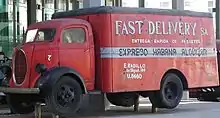
Twenty men out of the one hundred of Batista's presidential guard were killed.[5] Forty-two men participated in the attack against the Palace, 34 were from the Partido Autentico, and the rest from the Student Directory.[6]
Dead in the Palace Action:[7]
- Menelao Mora Morales, 52
- Carlos Gutíerrez Menoyo (brother of Eloy Gutiérrez Menoyo), 34
- José Luis Gómez Wangüemert, 31
- José Briñas Garcia, 26
- Ubaldo (Waldo) Diaz Fuentes, 28
- Abelardo Rodriguez Mederos, 30 (driver of one of the cars)
- José Castellanos Valdes, (alias "Ventrecha"), 35
- Evelio Prieto Guillaume, 33
- Adolfo Delgado
- Eduardo Panizo Bustos, 32
- Pedro Esperon, 45
- Reinaldo León Llera, 39
- Norberto Hernández Nodal, 45
- Pedro Nulasco Monzón, 30
- Pedro Tellez Valdes, 37
- Mario Casañas Díaz, 28
- Asterlo Enls Masa de Armas, 25
- Gerardo Medina Candentey
- Carlos Manuel Pérez Domingues, 45
- Angel Salvador González González, 54
- Adolfo Raúl Delgado Rodriguez, 29
- Ramón Alraro Betancourt, 36
- Celestino Pacheco
- Eduardo Domingues Aguilar, 50
- Pedro Zayden Rivera, 25
- Luis Felipe Almeida Hernandez, 35
- José Hernández
- Salvador Alfaro
- Ormani Arenado Llonch
Radio Reloj
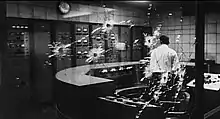
The combatants departed from a basement apartment located on Calle 19 between Calles B and C towards the Radiocentro CMQ Building in three automobiles:[8]
- First Automobile:
- Humberto Castelló Aldanás
- José [El Moro] Asseff
- Enrique Rodríguez Loeches
- Pedro Martínez Brito
- Aestor Bombino
- Second Automobile:
- José Antonio Echeverría
- Fructuoso Rodríguez
- Joe Westbrook
- Otto Hernández
- Carlos [El Chino] Figueredo
- Third Automobile:
- Julio García Oliveras
- Juan Nuiry Sánchez
- Mario Reguera
- Antonio [Ñico] Guevara
- Héctor Rosales[9]
The action of Radio Reloj, located in the Radiocentro CMQ Building at Calle 23 and L in El Vedado, was directed by José Antonio Echeverría who was accompanied among others, by Fructuoso Rodríguez, Joe Westbrook, Raúl Diaz Argüelles, Julio García Olivera, including reading a prepared statement announcing the execution of Batista by Echevarria:
"People of Cuba, in these moments the dictator Fulgencio Batista has just been justified. In his own burrow of the Presidential Palace, the people of Cuba have come to settle accounts. And it is we, the Revolutionary Directory, who in the name of the Cuban Revolution have given the shot of grace to this regime of opprobrium. Cubans listening to me. It's just been removed..."
The operation failed because Batista was never killed and the troops guarding the Radio Reloj transmission tower in Arroyo Arenas knocked down the transmission. José Antonio was shot and killed by a Batista patrol car on the corner of November 27 and L, on his way back to the University.[1]
.jpg.webp)

Surviving the attack :
- Angel Eros
- Amador Silveriño (driver of the "Fast Delivery" truck.)
- Orlando Manrique
- Orlando Lamadrid Velazco
- Sergio Pereda Velazco
- Santiago Aguero
- Manuel Toranzo
- Ricardo Olmedo (injured during attack; later, shot for attempting to kill Fidel Castro), 40
- Faure Chaumón Mediavilla[1]
- Antonio Castell Valdes
- Juan Gualberto Valdes
- José M. Olivera
- Marcos Leonel Remigio González
- Juan José Alfonso Zuñiga
- Evelio Álvarez
- Luís Goicochea
Dead at Radio Reloj attack:
- Jose Azef[or Asseff]
- Aestor Bombino
- Jose Antonio Echevarria
- Otto Hernandez
- Pedro Martinez Brito
#7 Humboldt Massacre, 20 April 1957
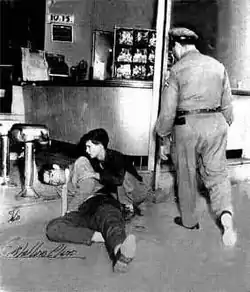
Several students that had taken part in the Presidential Palace attack were killed by Lt. Colonel of the Police Esteban Ventura Novo in the afternoon of 20 April 1957 at apartment 201 of No. 7 Humboldt Street. "A little after 5 PM on Saturday April 20th, the four young men were talking quietly, unaware of what was going on out on the street. They didn’t even suspect that the whole block had been surrounded and that Ventura’s henchmen were secretly making their way up the building’s stairs, at the speed of hyenas looking for blood."[10] JP Carbó was additionally sought by police for the assassination of Col. Antonio Blanco Rico, Chief of Batista's secret service.[11] The event has been called “The Humboldt 7 Massacre. "In 1964 the revolutionary courts of the Castro government tried and convicted Marcos Rodríguez Alfonso, aka “Marquitos”, for tipping the police to the Humboldt hideout. Marcos was executed by a firing squad.[12][13]
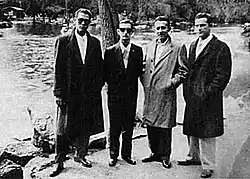
Declarations
Neighbors living in the surrounding area stated:[14]
A chief of police and his henchmen began to violently break the door with the butts of their weapons where the young revolutionaries were.
On this fact Rodríguez Loeches participant in the assault on Radio Reloj, stated:
Joe came to the apartment downstairs and asked the tenant to let him be in the living room as if it were on a visit. Soon after they knocked on the door and he opened. He was recognized by the hitmen and although she begged for the young man's life, he barely walked a few steps, when a burst of machine gun ended his life, he was just over twenty years old
He then referred to Juan Pedro Carbó Serviá, when he said:
Carbó went to the elevator, but was intercepted before arriving and being unmercifully machine-gunned. His whole face and body were shot
The young combatant Rodríguez Loeches continued his testimony and noted:
Machadito and Fructuoso darted throughs by a window towards the ground floor. They fell into a long and narrow passageway that belonged to a car agency. At the end there was a gate with a padlock that prevented their exit. As the place from which they fell was too high, Fructuoso lay unconscious on the ground, while Machadito made supreme efforts to rise for he had fractured both ankles. The hitmen inserted a machine gun between the bars and both fighters were shot
Killed at #7 Humboldt
- Juan Pedro Carbó [Carbo]
- José [Jose] Machado
- Fructuoso Rodríguez [Rodriguez]
- Jose or Joe Westbrook
Trial
The Havana Urgency court announced there would be a trial on April 5, 1957, for those charged in the March 13 attacks. Two individuals were under arrest to be tried: Orlando Olmedo Moreno, wounded during the attack, and Efrain Alfonso Liriano. All others connected with the attack either escaped or were killed.[15]
Public Act of Redress
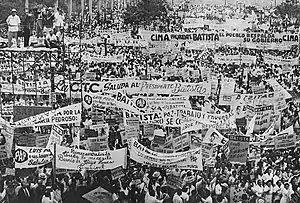
The public act of redress by the people of Havana for the assault of March 13 on the Presidential Palace took place on April 7 of 1957. It was reported that more than 250,000 people attended. Following is a report:
By R. Hart Phillips
Special to the New York Times.
HAVANA, April 7—Thousands of persons marched to the Presidential Palace this afternoon to signify their support of President Fulgencio Batista. Representatives of labor, commerce, industry, Government, political parties and supporters of the Administration filled the park in front of the palace and all adjacent streets. Placards and banners carried by the marchers proclaimed approval of General Batista’s policies, his public works program and his efforts to suppress the revolutionary activities of his enemies.One large banner said, “For Batista, in the Past, Now and Forever.”Another read “Five Hundred American Residents of the Isle of Pines Have Faith in Batista.”The keynote of the demonstration was “Peace.”Flocks of white doves were released during the demonstration to signify a demand for peace. Precautionary measures were taken by the Government to protect the demonstrators. Policemen armed with rifles surrounded the palace. On all near-by roofs policemen and soldiers armed with rifles and machine guns were on duty.[16]
Golpeando Arriba
On January 22, 1959, Fidel Castro explained to journalists gathered in the Copa Room of the Havana Riviera hotel, among other topics, that hitting up, "golpear arriba," was one of the "false concepts about the revolution" because "tyranny is not a man; tyranny is a system (...) We were never supporters of tyrannicide or military coups, [which tended] to inculcate the people a complex of impotence "[3] A few months earlier Castro had reprimanded Guevara for having signed a pact with Rolando Cubela, Chomon's lieutenant in the DR-13-3 guerrilla in Escambray mountains, the "Pacto del Pedrero". The letter is dated in Palma Soriano on December 26, 1958, in its crucial passage reads:
"You are committing a serious political error by sharing your authority, your prestige and your strength with the Revolutionary Directorate. There is no sense in raising a small group whose intentions and ambitions we know so well, and which in the future will be a source of problems "[3]
Gallery
 Jose Antonio Echevarria. Dead on March 13, 1957.
Jose Antonio Echevarria. Dead on March 13, 1957. Antonio Echevarria's girlfriend days after the attack. Havana, 1957.
Antonio Echevarria's girlfriend days after the attack. Havana, 1957. Antonio Echevarria's mother. Havana, 1957.
Antonio Echevarria's mother. Havana, 1957. Antonio Echevarria funeral. Havana, 1957.
Antonio Echevarria funeral. Havana, 1957.
References
- "LA SIERRA y el LLANO" (PDF). Archived (PDF) from the original on 2018-11-02. Retrieved 2018-11-01.
- "The Cuban Revolution Attack on the Presidential Palace (March 13, 1957)". Archived from the original on October 22, 2018. Retrieved 2018-10-22.
- "13 de Marzo: crisis del golpe arriba". Archived from the original on 2018-10-22. Retrieved 2018-10-22.
- "Palace Attack Trial Set April 5, 2 Set Charged". Archived from the original on 2018-10-25. Retrieved 2018-10-28.
- "Rebel Suicide Wiped Out" (PDF). Archived (PDF) from the original on 2019-04-30. Retrieved 2018-11-01.
- "Verdades del Ataque al Palacio Presidencial el 13 de Marzo de 1957" (PDF). Archived (PDF) from the original on 2018-10-28. Retrieved 2018-10-22.
- "No Eran Estudiantes los Que Asaltaron el Palacio" (PDF). Archived (PDF) from the original on 2018-10-28. Retrieved 2018-10-28.
- "ANIVERSARIO DEL ATAQUE AL PALACIO PRESIDENCIAL DE CUBA". Archived from the original on 2019-08-12. Retrieved 2019-08-12.
- "CUBAN INFORMATION ARCHIVES, Doc 0128". Archived from the original on 2019-08-12. Retrieved 2019-08-12.
- "The Martyrs of Humboldt 7". Archived from the original on 2019-08-12. Retrieved 2018-10-28.
- "Humboldt 7 y el hombre que delató a mi padre". Archived from the original on 2019-08-12. Retrieved 2019-08-12.
- "1957: Humboldt 7 Shootings". Archived from the original on 2018-10-28. Retrieved 2018-10-28.
- "Marquitos, ¿inocente o culpable?". Archived from the original on 2018-12-29. Retrieved 2019-08-12.
- "Masacre de Humboldt 7". Archived from the original on 2019-08-15. Retrieved 2019-08-15.
- "Palace Attack Trials" (PDF). Archived (PDF) from the original on 2018-10-28. Retrieved 2018-09-15.
- "Thousands of Cubans March in Havana to Show Support for Batista". Archived from the original on 2018-10-30. Retrieved 2018-10-22.
Notes
- The house of the three cents.
Additional reading
External links
- "Tragic events of Wednesday March 13"
- Revolt in Havana. Chicago Daily Tribune. March 14, 1957.
- Asalto al Palacio Presidencial y toma de la emisora Radio Relo on YouTube
- La toma de Radio Reloj on YouTube
See also
| Wikimedia Commons has media related to Havana Presidential Palace attack (1957). |
